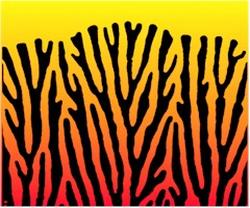Burning Under Control

When a coffee spill spreads on a counter top or a salt crystal grows in salty water, the system usually spreads with “fingers,” instead of a simple straight front at the leading edge. According to a report in the 2 November PRL, fire can propagate in similar patterns. The authors demonstrate that despite the complexity of combustion, they could control the blackening of a burning piece of paper and explain characteristics of the burn patterns. They also suggest that low-temperature smoldering of the type they observed can occur in confined spaces beyond the reach of fire detectors.
Burning is a complex process involving many chemical reactions along with complicated air flows. Usually the rising of hotter air (convection) that drives these air flows makes controlling and following burning patterns difficult. Ory Zik is part of a team at the Weizmann Institute of Science in Israel that built a special cell to prevent convection, allowing them unprecedented control over the burning process. They placed a piece of paper horizontally on top of a metal plate with a hot wire at one end and covered it with a glass plate, leaving only a small space above the paper. With oxygen gently blown in from the cooler end, they photographed the paper as it gradually blackened from one end to the other. There was no visible flame because the burning was relatively cool in this “smoldering” regime.
The fingering patterns the team observed were also seen independently, at about the same time, on NASA’s Space Shuttle, another convection-free environment. But Zik jokes that simpler experiments are needed “if you live in a small country like Israel and you don’t have the Space Shuttle.” The Weizmann group found the patterns had two distinct length scales that they could control independently. The spacing between fingers was determined by the flow rate of oxygen gas, and the width of individual fingers was mainly influenced by the heat loss properties of the paper. They draw qualitative analogies to other slowly advancing “frontal” systems, such as growing crystals.
The team found that, as in other systems where finger patterns form, diffusion has a strong influence. Other researchers have learned that the position of the burning front is determined largely by competition between two of the reaction’s basic needs: abundant oxygen ahead of the front and high temperature behind it. Zik considers his group’s results to be an experimental demonstration of this theory. The team also has one very practical conclusion: They suggest that the weak, sustained mode of burning they observed could develop in narrow spaces within aircraft walls and would be too cool to set off fire alarms.
“It’s first class work,” says Bernard Matkowsky of Northwestern University in Evanston, IL. He says that complicated reactions like combustion are usually very difficult to control experimentally, but such experiments are needed to show that the basic theories of pattern formation apply to combustion phenomena as well as other systems.


